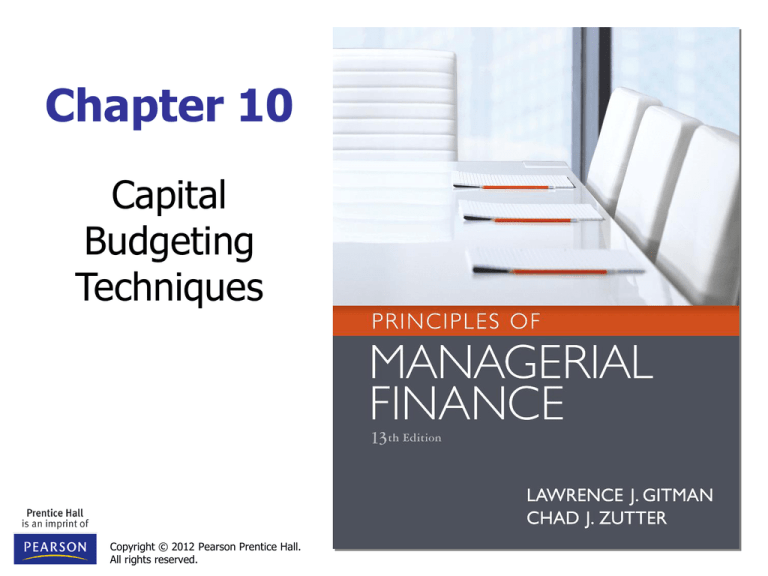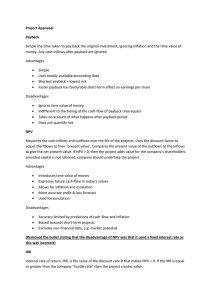
Chapter 10
Capital
Budgeting
Techniques
Copyright © 2012 Pearson Prentice Hall.
All rights reserved.
Overview of Capital
Budgeting
Capital budgeting is the process of evaluating
and selecting long-term investments that are
consistent with the firm’s goal of maximizing
owner wealth.
A capital expenditure is an outlay of funds by the
firm that is expected to produce benefits over a
period of time greater than 1 year.
An operating expenditure is an outlay of funds
by the firm resulting in benefits received within 1
year.
10-2
What is capital budgeting?
Analysis of potential additions to fixed assets.
Long-term decisions; involve large
expenditures.
Very important to firm’s future.
Categories of Capital Budgeting:
Replacements needed to continue current
operations. For damaged assets.
Replacement for cost reduction due to obsolete
assets.
Expansion of existing products or markets.
Expansion into new products and markets.
10-3
What is the difference between
independent and mutually exclusive
projects?
Independent projects – if the cash flows
of one are unaffected by the acceptance of
the other.
Mutually exclusive projects – if the
cash flows of one are adversely impacted
by the acceptance of the other.
10-4
What is the difference between normal
and nonnormal cash flow streams?
Normal cash flow stream – Cost (negative
CF) followed by a series of positive cash
inflows. One change of signs.
Nonnormal cash flow stream – Two or
more changes of signs. Most common:
Cost (negative CF), then string of positive
CFs, then cost to close project.
10-5
Criteria to evaluate Capital
Budgeting Projects
Five methods are used to evaluate projects:
(1) Payback
(2) Discounted payback
(3) Net Present Value (NPV)
(4) Internal Rate of Return (IRR)
(5) Modified Internal Rate of Return (MIRR)
10-6
What is the payback
period?
The number of years required to recover a
project’s cost by its net revenue, or “How
long does it take to get our money back?”
Calculated by adding project’s cash inflows to
its cost until the cumulative cash flow for the
project turns positive.
10-7
Calculating payback (when
uneven CF)
Project L
CFt
Cumulative
PaybackL
Project S
CFt
Cumulative
PaybackS
0
-100
-100
== 2
2
2.4
3
10
-90
60
-30
100
0
80
30 / 80
+
0
1.6
1
-100
-100
== 1
1
70
-30
+
= 2.375 years
2
100 50
0 20
30 / 50
50
3
20
40
= 1.6 years
10-8
Calculating payback (When
the cash flows are equal)
Project A
CFt
0
1
2
2.2
3
-100
45
45
100
45
Pay Back Period= $100/45
= 2.22 years
10-9
Payback Period Decision criteria:
The payback method is the amount of time required
for a firm to recover its initial investment in a project,
as calculated from cash inflows.
Decision criteria:
The length of the maximum acceptable payback
period is determined by management.
If the payback period is less than the maximum
acceptable payback period, accept the project.
If the payback period is greater than the
maximum acceptable payback period, reject the
project.
10-10
Strengths and weaknesses of
payback
Strengths
Provides an indication of a project’s risk
and liquidity.
Easy to calculate and understand.
Weaknesses
Ignores the time value of money.
Ignores CFs occurring after the payback
period.
10-11
Discounted payback period
Uses discounted cash flows rather than raw CFs.
The length of time required for an investment’s cash
flows, discounted at the investment’s cost of capital,
to cover its cost.
0
10%
CFt
PV of CFt
-100
-100
Cumulative
-100
Disc PaybackL ==
2
10
60
49.59
80
60.11
-41.32
18.79
10/(1+.10)^1=9.09
-90.91
2
+
2.7 3
1
41.32 / 60.11
= 2.7 years
10-12
Net Present Value (NPV)
Net present value (NPV) is a sophisticated capital
budgeting technique; found by subtracting a project’s
initial investment from the present value of its cash
inflows discounted at a rate equal to the firm’s cost
of capital.
NPV = Present value of cash inflows – Initial
investment
10-13
Net Present Value (NPV)
(cont.)
Decision criteria:
If the NPV is greater than $0, accept the
project.
If the NPV is less than $0, reject the project.
If the NPV is greater than $0, the firm will earn a
return greater than its cost of capital. Such action
should increase the market value of the firm, and
therefore the wealth of its owners by an amount
equal to the NPV.
10-14
Figure 10.2 Calculation of NPVs for Bennett
Company’s Capital Expenditure Alternatives
10-15
Project Decision based on NPV
NPV
= PV of inflows – Cost
= Net gain in wealth
If projects are independent, accept if the project
NPV > 0.
If projects are mutually exclusive, accept projects
with the highest positive NPV, those that add the
most value.
For example, accept Project A, if mutually exclusive
(if, NPVA > NPVB)
If no project has a positive NPV, reject them all.
10-16
Internal Rate of Return
(IRR)
A project’s IRR is the discount rate that
forces the PV of cash inflows to equal the
cost (initial outlay).
This is equivalent to forcing the NPV to equal
zero .
The IRR is an estimate of the project’s rate of
return, and it is comparable to the YTM on a
bond.
10-17
Rationale for the IRR method
If IRR > WACC, the project’s rate of
return is greater than its costs.
There is some return left over to
boost stockholders’ returns.
10-18
Project decision based on IRR
Independent projects: If IRR exceeds
the project’s WACC (k) accept the
project and vice versa.
Mutually exclusive projects: Accept the
project with the highest IRR, provided
the IRR is greater than WACC. Reject all
projects if the best IRR does not exceed
WACC.
10-19
IRR Acceptance Criteria
If IRR > k, accept project.
If IRR < k, reject project.
If projects are independent, accept
both projects, as both IRR > k
If projects are mutually exclusive,
accept A, because IRRA > IRRB.
10-20
NPV vs IRR
IRR is logically appealing since it is useful
to know rates of return on proposed
investments.
However when NPV and IRR give
conflicting conclusions then it is better to
decide based on NPV.
◦
◦
NPV assumes cash flows are reinvested at
WACC which is possible in reality.
IRR assumes cash flows are reinvested at IRR
which is flawed.
10-21









